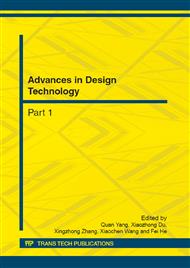[1]
N. Cross and A. Clayburn Cross: Research in Engineering Design - Theory, Applications, and Concurrent Engineering Vol. 10 (1998), pp.141-149
Google Scholar
[2]
N. P. Suh: The principles of design (Oxford, New York 1990).
Google Scholar
[3]
G. Pahl and W. Beitz: Engineering design: A systematic approach. (Springer-Verlag, London 1995).
Google Scholar
[4]
B. V. Koen: Definition of the engineering method (American Society for Engineering Education., Washington 1985).
Google Scholar
[5]
E. Kroll, S. S. Condoor and D. G. Jansson: Innovative conceptual design: Theory and application of parameter analysis. (Cambridge University Press., Cambridge 2001).
DOI: 10.1017/cbo9780511612923
Google Scholar
[6]
M. French: Conceptual design for engineers (Springer, London 1999).
Google Scholar
[7]
T. Lewis: Journal of research in science teaching Vol. 43 (2006), pp.255-281
Google Scholar
[8]
W. Visser: Design Studies Vol. 30 (2009), pp.187-223
Google Scholar
[9]
O. Akin, in: Variants in Design Cognition, edited by E. C., W. Newstetter and M. McCracken chapter, 6, Elsevier Science, (2001).
Google Scholar
[10]
K. Ehrlenspiel and N. Dylla: Journal of Engineering Design Vol. 4 (1993), p.
Google Scholar
[11]
C. J. Atman, R. S. Adams, M. E. Cardella, J. Turns, S. Mosborg and J. Saleem: Journal of Engineering Education Vol. (2007), pp.359-379
DOI: 10.1002/j.2168-9830.2007.tb00945.x
Google Scholar
[12]
D. A. Schön: The Refelctive Practioner (Temple-Smith, London 1983).
Google Scholar
[13]
N. Cross: Designerly Ways of Knowing (Springer-Verlag, London 2006).
Google Scholar
[14]
K. Dorst and N. Cross: Design Studies Vol. 22 (2001), pp.425-437
Google Scholar
[15]
E. de Bono: Six Thinking hats (Penguin Books, 1985).
Google Scholar
[16]
L. L. Bucciarelli: Design Studies Vol. 9 (1988), pp.159-168
Google Scholar
[17]
F. Coley, O. Houseman and R. Roy: Journal of Engineering Design Vol. 18 (2007), pp.311-325
Google Scholar
[18]
A. Oak: Design Studies Vol. 32 (2011), pp.211-234
Google Scholar
[19]
B. Burns: Introduction to Research Methods (Longman Cheshire, Melbourne 1994).
Google Scholar
[20]
L. M. Kiisk: Journal of Constuction Education Vol. 3 (1998), pp.213-222
Google Scholar
[21]
M. A. Rhamdhani, K. Salehi, Y. C. Wong and A. Kapoor: proceedings of the 2009 AaeE conference Vol. (2009), p.
Google Scholar
[22]
N. Schadewitz: International Journal of Design Vol. 3 (2009), pp.37-53
Google Scholar
[23]
S. Daly: Proceedings of the ASEE Conference Vol. (2009), p.
Google Scholar
[24]
E. U. Weber and C. K. Hsee: Applied Psychology: An international review Vol. 49 (2000), pp.32-61
Google Scholar
[25]
T. Buzan and B. Buzan: The Mind Map Book (BCC Worldwide Limited, London 1993).
Google Scholar
[26]
A. M. G.-M. Arce-Ibarra, A.I.: The International Journal of Interdisciplinary Social Sciences Vol. 2 (2007), pp.39-52
Google Scholar
[27]
C. D. Buckingham, A. Adams and C. Mace: Journal of Mental Health Vol. 17 (2008), pp.299-314
Google Scholar
[28]
Z. Weize and Q. Feiyue: 2011 International Symposium on IT in Medicine and Education (ITME) Vol. (2011), pp.485-489
Google Scholar
[29]
D. Koznov, E. Larchik, M. Pliskin and N. Artamonov: Programming and Computer Software Vol. 37 (2011), p.315–321
DOI: 10.1134/s036176881106003x
Google Scholar
[30]
L. L. Bucciarelli: Design Studies Vol. 23 (2002), pp.219-231
Google Scholar
[31]
R. E. Nisbett: The geography of thought: How Asians and westerners think differently and why (Free Press, New York 2004).
DOI: 10.1525/ctx.2004.3.1.63
Google Scholar
[32]
M. B. Teagarden, J. Meyer and D. Jones: Organizational dynamics Vol. 37 (2008), pp.190-202
Google Scholar
[33]
L. D. Rainey: Confucius and Confucianism: The Essentials (John Wiley & Sons, Ltd, Chichester 2010).
Google Scholar
[34]
J. K. Nielsen: Journal of Chinese Economic and Business Studies Vol. 8 (2010), pp.23-44
Google Scholar
[35]
J. F. Yates and J. W. Lee, in: Chinese Decision-making, edited by M. H. Bond chapter, 22, Oxford University Press (China) Ltd, Hong Kong (1996).
Google Scholar
[36]
L. Gow, J. Balla, D. Kember and K. T. Hau, in: The learning approaches of Chinese people: A function of socializayion processes and the context of learning?, edited by M. H. Bond chapter, 8, Oxford University Press (China) ltd, Hong Kong (1996).
Google Scholar
[37]
D. P. S. Bhawuk: Progress in Development Studies Vol. 21 (2009), pp.161-181
Google Scholar


